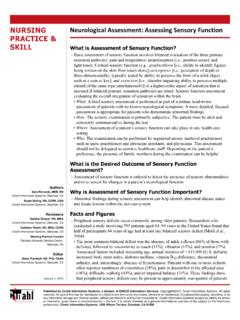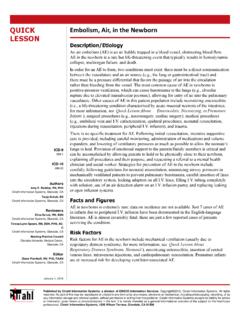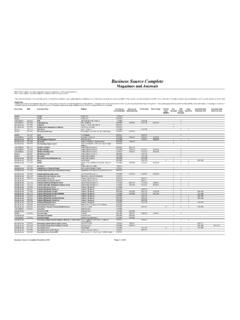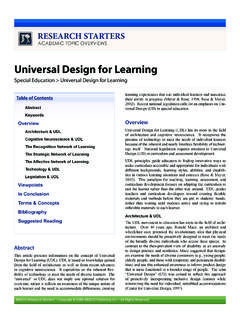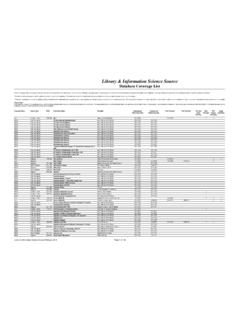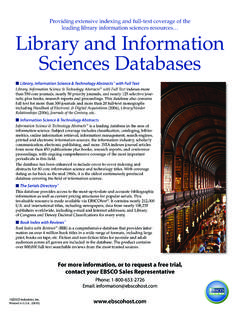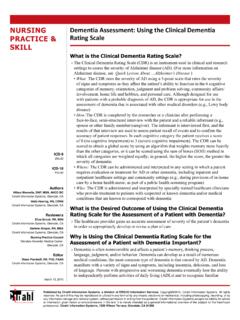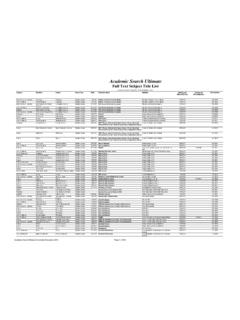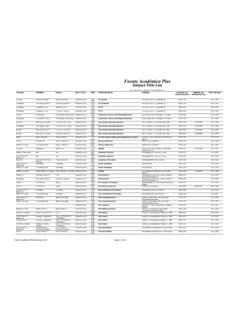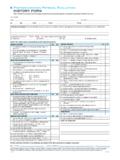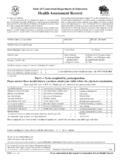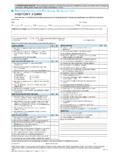Transcription of CHECKLIST COMPETENCY Neurological Assessment: …
1 Published by Cinahl Information Systems, a division of EBSCO Information Services. Copyright 2015, Cinahl Information Systems. All rightsreserved. No part of this may be reproduced or utilized in any form or by any means, electronic or mechanical, including photocopying, recording, or byany information storage and retrieval system, without permission in writing from the publisher. Cinahl Information Systems accepts no liability for adviceor information given herein or errors/omissions in the text. It is merely intended as a general informational overview of the subject for the healthcareprofessional. Cinahl Information Systems, 1509 Wilson Terrace, Glendale, CA 91206 SKILLCOMPETENCYCHECKLISTN eurological Assessment: Assessing Sensory Met/InitialsCompetency AreasPrerequisite SkillsUnderstanding of the rationale for completing an assessmentof sensory functionUnderstanding of how to complete the assessmentKnowledge of expected outcomes of the sensory testsKnowledge of the importance of sensory dermatomes andtheir relevance to sensory functionPreparationReviews facility/unit-specific protocols for assessing sensoryfunction, if one is availableReviews treating clinician s written orders for assessment ofsensory functionVerifies completion of facility informed consent documentsReviews the patient s medical history/medical record for allergies ( , latex); uses alternate materials, if appropriate history of Neurological deficit or disorderAssembles the following supplies: Personal protective equipment (PPE; , sterile/nonsterilegloves.)
2 Use additional PPE [ , gown, mask, eye protection]if exposure to body fluids is anticipated) Cotton wisp Tongue blade Tuning fork Coin or key 2 containers; one containing warm water and the othercontaining cold water Written information, if available, to reinforce verbaleducationProcedurePerforms hand hygiene and dons PPE, as appropriateIdentifies patient using two unique identifiers or facilityprotocolEstablishes privacy by closing the door to the patient s roomand/or drawing the curtain around the bedIntroduces self to the patient and family members andexplains clinical role in the assessment of sensory function Assesses patient/family anxiety and for knowledge deficitsregarding the assessment Evaluates whether the patient/family requires specialconsiderations regarding communication ( , dueto illiteracy, language barriers, or deafness); makesarrangements to meet these needs, if present Follows facility protocols for using a professional certifiedmedical interpreter when a communication barrier exists Explains the purpose and details of the assessment of sensoryfunction that you will be doing simple painless teststhat require a patient response.
3 Answers any questions andprovides emotional support as neededInstructs the patient to close his/her eyes and to keep themclosed until instructed to open themAssesses tactile sensation as follows: Tells the patient that he/she will be touched with an objectand asks him/her to say the word now when the touch isfelt Lightly touches a cotton wisp to the face, torso, and all fourlimbs Notes response to each touchAssesses tactile identification sensation (tests stereognosis) asfollows: Tells the patient that a common object will be placed intohis/her hand and asks that he/she identify the object by touchalone Places a common object such as a coin or key in the patient shand; repeats the process for the opposite hand Notes the patient s responseAssesses sharp/dull sensation as follows: Tells the patient that he/she will be touched with a sharp ordull object and asks him/her to identify the touch when felt Breaks a tongue blade in half Lightly touches the sharp end of the blade on all four limbs;repeats with the dull end of the blade Notes patient response to all touchesAssesses vibration sensation as follows: Tells the patient that he/she will be touched with a metalobject Asks the patient to identify when the vibration sensationceases Strikes the tuning fork Places the handle of the tuning fork over a bony prominenceon the distal joint of the great toe or the proximal thumb jointbody.
4 Repeats the process for the same joint on the oppositeside of the bodyAssesses proprioception sensation as follows: Tells the patient that his/her great toe or index finger will bemoved, and asks the patient to indicate the direction his/hergreat toe or index finger are moved Moves the great toe or index finger up and down; repeats theprocess for the same joint on the opposite side of the body Notes the patient s responses to all touchAssesses temperature sensation as follows: Tells the patient that his/her hand will be placed in warm andcold water Instructs the patient to identify if the water is warm or cold Repeats the process for the opposite hand Notes the patient s responses to all attemptsInstructs the patient to open his/her eyesDiscards used procedure materials according to facilityprotocolPerforms hand hygienePost-Procedural ResponsibilitiesReports abnormal test results to the treating clinician asappropriate, according to facility protocolUpdates the patient s plan of care, if appropriate, anddocuments the following information in the patient s medicalrecord.
5 Date and time of patient assessment Results of sensory assessment Any unexpected events that occurred, interventionsperformed, and if the treating clinician was notified All patient/family education, including topics presented,response to education provided/discussed, plan forfollow-up education, and details regarding any barriers tocommunication and/or techniques that promoted 's SignatureDate.
